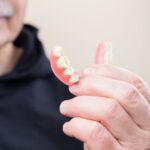If you’re curious about partial dentures and want to know more about these remarkable dental appliances, you’ve come to the right place. In this article, we’ll uncover the essential facts about partial dentures, delving into the different types available, along with the crucial aspects of care and maintenance. Whether you’re someone with missing teeth or simply intrigued by the field of dental prosthodontics, get ready to discover the intriguing world of partial dentures and the incredible benefits they offer. So, let’s dive in and unveil the fascinating facts about partial dentures!

Facts About Partial Dentures
Partial dentures are an excellent option for individuals with missing teeth who are looking to restore their smile, improve functionality, and maintain oral health. Whether you are considering partial dentures for yourself or want to learn more about them, this article will provide you with essential facts about partial dentures that will help you make an informed decision.
Customized Solutions for Missing Teeth
When it comes to replacing missing teeth, partial dentures offer a versatile and customizable solution. These removable dental appliances are crafted to fit snugly in your mouth and replace one or more missing teeth. Designed to blend seamlessly with your natural teeth, partial dentures not only restore your smile but also provide support to adjacent teeth, prevent further tooth loss, and improve chewing functionality.
Partial dentures are made using high-quality materials that mimic the natural appearance of teeth and gums, ensuring a lifelike and aesthetically pleasing result. With advancements in dental technology, modern partial dentures have become more comfortable, durable, and natural-looking than ever before.
Types of Partial Dentures
When considering partial dentures, it’s important to understand the different types available to determine the best option for your specific needs. Here are the two main types of partial dentures:
Acrylic Removable Partial Dentures: Acrylic removable partial dentures are a cost-effective and flexible option for replacing missing teeth. They consist of a pink acrylic base to mimic the appearance of your gums, with replacement teeth attached to it. This type of partial denture is easily removable for daily oral hygiene routines.
Metal Framework Removable Partial Dentures: Metal framework removable partial dentures are crafted using a thin metal framework that provides strength and stability. They offer a more lightweight and discreet option compared to acrylic partial dentures. The metal framework is customized to fit around your remaining teeth, providing a secure fit. Metal partial dentures are highly durable and less prone to damage.
Quote: “Partial dentures offer a versatile and customizable solution, providing support to adjacent teeth, preventing further tooth loss, and improving chewing functionality.”
Caring for Your Partial Dentures
Proper care and maintenance are essential for ensuring the longevity and optimal performance of your partial dentures. Here are some tips to keep in mind:
Daily Cleaning: Clean your partial dentures thoroughly every day to remove bacteria, food particles, and plaque. Use a soft-bristled toothbrush or denture brush along with a non-abrasive denture cleanser or mild soap. Avoid using toothpaste or abrasive cleaners, as they can damage the denture materials.
Soak Overnight: When not in use, it’s recommended to soak your partial dentures in a denture-cleansing solution or plain water overnight. This helps to keep them moist and prevents warping.
Handle with Care: Handle your partial dentures with care to avoid dropping or damaging them. When removing or inserting your dentures, do it over a soft towel or basin of water to minimize the risk of breakage.
Regular Dental Check-ups: Visit your dentist regularly for check-ups and professional cleanings. Your dentist will examine the condition of your partial dentures, make any necessary adjustments, and assess the health of your remaining teeth and gums.
Quote: “Proper care and maintenance are essential for ensuring the longevity and optimal performance of your partial dentures.”
Pros and Cons of Partial Dentures
Partial dentures come with their own set of advantages and considerations to keep in mind. Here are some of the pros and cons of partial dentures:
Pros:
– Cost-effective compared to other tooth replacement options.
– Non-invasive procedure that doesn’t require surgery.
– Versatile and customizable to fit your specific needs.
– Improves your ability to chew and speak properly.
– Restores your smile and boosts self-confidence.
Cons:
– May require adjustments as your mouth changes over time.
– Initial discomfort during the adjustment period.
– Requires proper care and regular maintenance.
– Not as stable as dental implants or dental bridges.
– Can potentially affect the taste and feel of food.
Quote: “Partial dentures come with their own set of advantages and considerations to keep in mind.”
In conclusion, understanding the facts about partial dentures allows you to make informed decisions about your dental health. Whether you opt for acrylic or metal framework partial dentures, ensuring proper care and maintenance is crucial for their longevity. With their ability to restore your smile, improve functionality, and provide a comfortable fit, partial dentures can greatly enhance your quality of life. Take the next step and consult with a dental professional to determine if partial dentures are the right solution for you.
[Ref A: 650d81faabdb4bae8719f3e4ef8f6e96]
[Ref B: PUSEEAP00009D8B]
Dentures have come a long way in modern dentistry. If you’re curious about the fascinating world of dentures, you’ll be amazed by these incredible facts about dentures. From their history to the latest advancements, the world of dentures has a lot to offer. Click here to uncover the intriguing truths about dentures: facts about dentures. So, if you’re ready for an enlightening journey, don’t miss the chance to explore the captivating facts about dentures.
Facts about Partial Dentures: Did you know that partial dentures can provide numerous benefits for individuals in need of teeth replacement? These removable dental appliances offer both aesthetic and functional advantages. From improving your smile to enhancing your ability to chew comfortably, partial dentures can truly transform your daily life. Not to mention, they require minimal maintenance to keep them looking and feeling their best. Discover the numerous benefits of partial dentures and how their proper maintenance can ensure a long-lasting, natural-looking smile.
Interested in learning more about partial dentures? Check out these valuable partial denture facts to fully understand the benefits they offer. Whether you want to regain confidence in your smile or simply want to enjoy your favorite foods without any restrictions, partial dentures can be your perfect solution. Don’t miss out on this opportunity to enhance your quality of life. Explore the fascinating world of partial dentures and discover why they are a popular choice for teeth replacement.
To learn more about the facts surrounding partial dentures, visit our comprehensive guide here: partial dentures facts. It’s time to take control of your dental health and choose a reliable and effective solution that meets your needs.
In addition, discover the amazing benefits that partial dentures bring to your life. These dental prosthetics not only restore your missing teeth but also provide enhanced facial support, allowing you to maintain your natural facial contours. Say goodbye to self-consciousness and hello to a confident, radiant smile. To explore the remarkable benefits offered by partial dentures, click here: partial dentures benefits.
Remember, proper maintenance is key to preserving the longevity and appearance of your partial dentures. Discover the best practices for caring for your dental appliances to ensure they stay in optimal condition. Learn about denture cleaning solutions, brushing techniques, and other handy tips to keep your partial dentures as good as new. To find out more about the maintenance of partial dentures, click here: partial dentures maintenance.
Don’t miss out on the valuable information and exciting possibilities that partial dentures provide. Take the first step towards a brighter smile and a better quality of life by exploring the facts, benefits, and maintenance tips surrounding partial dentures. Start your journey now!
Acrylic vs Metal Partial Dentures: A Comprehensive Comparison
[youtube v=”aMTNL-2ezrs”]
Introduction
Partial dentures are becoming an increasingly popular and customizable option for individuals with missing teeth. They offer a versatile solution that mimics the natural appearance of teeth and gums. There are two main types of partial dentures available: acrylic removable partial dentures and metal framework removable partial dentures. Each type has its own unique advantages and considerations. In this article, we will explore the differences between acrylic and metal partial dentures, helping you make an informed decision about the best option for your specific needs.
Acrylic Dentures: Cost-effective and Easily Removable
Acrylic dentures are a cost-effective option for individuals who require partial dentures. They are easily removable, allowing for convenient cleaning and maintenance. These dentures consist of teeth and a plastic base that resembles the appearance of natural gums. However, it’s important to note that acrylic dentures tend to be thicker and bulkier compared to their metal counterparts. This can affect comfort and overall fit.
According to Mark Bates from the Denture Clinic, “The big disadvantage of acrylic dentures is that they’re very thick compared to metal dentures.”
Metal Framework Dentures: Lightweight, Discreet, and Durable
Metal framework dentures offer a lightweight and discreet alternative to acrylic dentures. These dentures use a metal base with teeth securely attached to it. The advantage of the metal framework is its ability to achieve a thinner and smaller design, making it more comfortable to wear. Metal dentures are also known for their durability, as they can last two to three times longer than acrylic dentures.
Mark Bates explains, “Being metal, we can get away with making it much thinner and much smaller, probably about a third of the size of acrylic dentures.”
Making the Choice: Factors to Consider
When choosing between acrylic and metal partial dentures, there are a few important factors to consider:
- Cost: Acrylic dentures are generally more affordable than metal dentures, making them a popular choice for individuals on a budget.
- Comfort and Fit: Metal dentures tend to offer a more comfortable fit due to their thinner and smaller design. This aspect becomes especially significant for those who prioritize comfort.
- Durability: Metal dentures have a longer lifespan and are more resistant to wear and tear compared to acrylic dentures. This aspect may be important for individuals seeking a long-term investment.
- Appearance: Both types of dentures are designed to closely resemble natural teeth and gums. However, metal dentures may offer a more discreet and aesthetically pleasing option due to their thin and lightweight construction.
Mark Bates advises, “Once you go from a plastic to a metal denture, you will never go back.”
Conclusion
In summary, when it comes to choosing between acrylic and metal partial dentures, the decision ultimately rests on personal preference and specific requirements. While acrylic dentures offer a cost-effective and easily removable solution, metal dentures provide a more lightweight, discreet, and durable option. It is crucial to consult with a dental professional to determine the best choice based on your individual needs and budget.
Remember, regardless of the type of partial denture you choose, proper care and maintenance are essential for their longevity and optimal performance. Regular cleaning, overnight soaking, gentle handling, and frequent visits to the dentist for check-ups are recommended to ensure the ongoing satisfaction and functionality of your dentures.
As Mark Bates concludes, “The choice between acrylic and metal dentures is definitely yours. Once you go from a plastic to a metal denture, you will never go back.”
[Quote]
FAQ
Question 1: What are partial dentures?
Answer 1: Partial dentures are removable dental prosthetics that are designed to replace one or more missing teeth. They consist of artificial teeth attached to a pink or gum-colored acrylic base, which is custom-made to fit the patient’s mouth.
Question 2: What are the benefits of partial dentures?
Answer 2: Partial dentures offer several benefits, including improved ability to chew and speak, enhanced appearance, and prevention of the remaining natural teeth from shifting out of position. They also provide support to the cheeks and lips, restoring facial structure and preventing a sunken appearance.
Question 3: What are the different types of partial dentures?
Answer 3: There are three main types of partial dentures: cast metal partial dentures, acrylic partial dentures, and flexible partial dentures. Cast metal partial dentures are durable and lightweight, while acrylic partial dentures are more affordable and easy to adjust. Flexible partial dentures, on the other hand, offer greater comfort and a more natural appearance.
Question 4: How should I care for my partial dentures?
Answer 4: Proper care and maintenance of partial dentures are essential to ensure their longevity and optimal function. It is important to remove and clean the dentures daily using a soft toothbrush and mild denture cleaner. They should be soaked in water or denture cleaning solution when not in use. Additionally, regular dental visits for adjustments and professional cleaning are necessary to maintain the fit and overall oral health.
Question 5: How often should partial dentures be replaced?
Answer 5: The lifespan of partial dentures can vary depending on individual factors such as oral hygiene, overall health, and wear and tear. On average, partial dentures may need to be replaced every 5 to 10 years. Regular dental check-ups can help determine if replacement is necessary and ensure the best possible fit and function.
- Crypto Quotes’ Red Flags: Avoid Costly Mistakes - June 30, 2025
- Unlock Inspirational Crypto Quotes: Future Predictions - June 30, 2025
- Famous Bitcoin Quotes: A Deep Dive into Crypto’s History - June 30, 2025
















